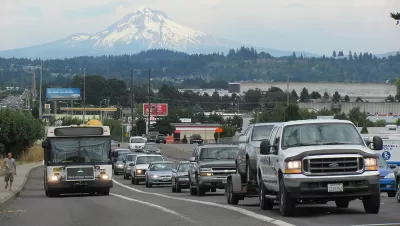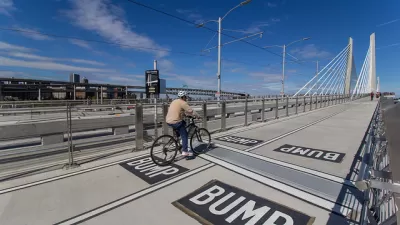Faced with an uptick in roadway fatalities, Oregon is looking at how to increase safety. But it's concentrating on highways while arterials actually account for the region's most severe crashes.

Over at City Observatory, Joe Cortright has been criticizing plans in Oregon and elsewhere to curb congestion by widening freeways. Here, he points out possibly faulty logic (or mixed priorities) in how Oregon's Department of Transportation is pursuing Vision Zero.
"If we're going to achieve Vision Zero, it really means concentrating our energy and resources on the serious crashes, and not the more numerous, but far less serious ones," Cortright writes. Fatalities on Oregon roads have been on the rise in recent years.
Pointing to a recent ODOT report [pdf] on traffic performance in the Portland region, Cortright says the department's priorities are skewed. "The report makes it clear that ODOT is primarily interested in crashes not because they kill and maim Oregonians, but because they're associated with slower freeway traffic."
More attention should be paid to safety on arterial roadways, Cortright says, than on highways, which are statistically safer in the area. "On average, the region's arterials have five times as many serious crashes per mile traveled as freeways, according to the Metro study, a finding they called 'one of the most conclusive relationships in this study.'" That study, which is several years old, can be found here.
FULL STORY: Dying to widen highways

Alabama: Trump Terminates Settlements for Black Communities Harmed By Raw Sewage
Trump deemed the landmark civil rights agreement “illegal DEI and environmental justice policy.”

Study: Maui’s Plan to Convert Vacation Rentals to Long-Term Housing Could Cause Nearly $1 Billion Economic Loss
The plan would reduce visitor accommodation by 25% resulting in 1,900 jobs lost.

Planetizen Federal Action Tracker
A weekly monitor of how Trump’s orders and actions are impacting planners and planning in America.

Waymo Gets Permission to Map SF’s Market Street
If allowed to operate on the traffic-restricted street, Waymo’s autonomous taxis would have a leg up over ride-hailing competitors — and counter the city’s efforts to grow bike and pedestrian on the thoroughfare.

Parklet Symposium Highlights the Success of Shared Spaces
Parklets got a boost during the Covid-19 pandemic, when the concept was translated to outdoor dining programs that offered restaurants a lifeline during the shutdown.

Federal Homelessness Agency Places Entire Staff on Leave
The U.S. Interagency Council on Homelessness is the only federal agency dedicated to preventing and ending homelessness.
Urban Design for Planners 1: Software Tools
This six-course series explores essential urban design concepts using open source software and equips planners with the tools they need to participate fully in the urban design process.
Planning for Universal Design
Learn the tools for implementing Universal Design in planning regulations.
Caltrans
Smith Gee Studio
Institute for Housing and Urban Development Studies (IHS)
City of Grandview
Harvard GSD Executive Education
Toledo-Lucas County Plan Commissions
Salt Lake City
NYU Wagner Graduate School of Public Service





























